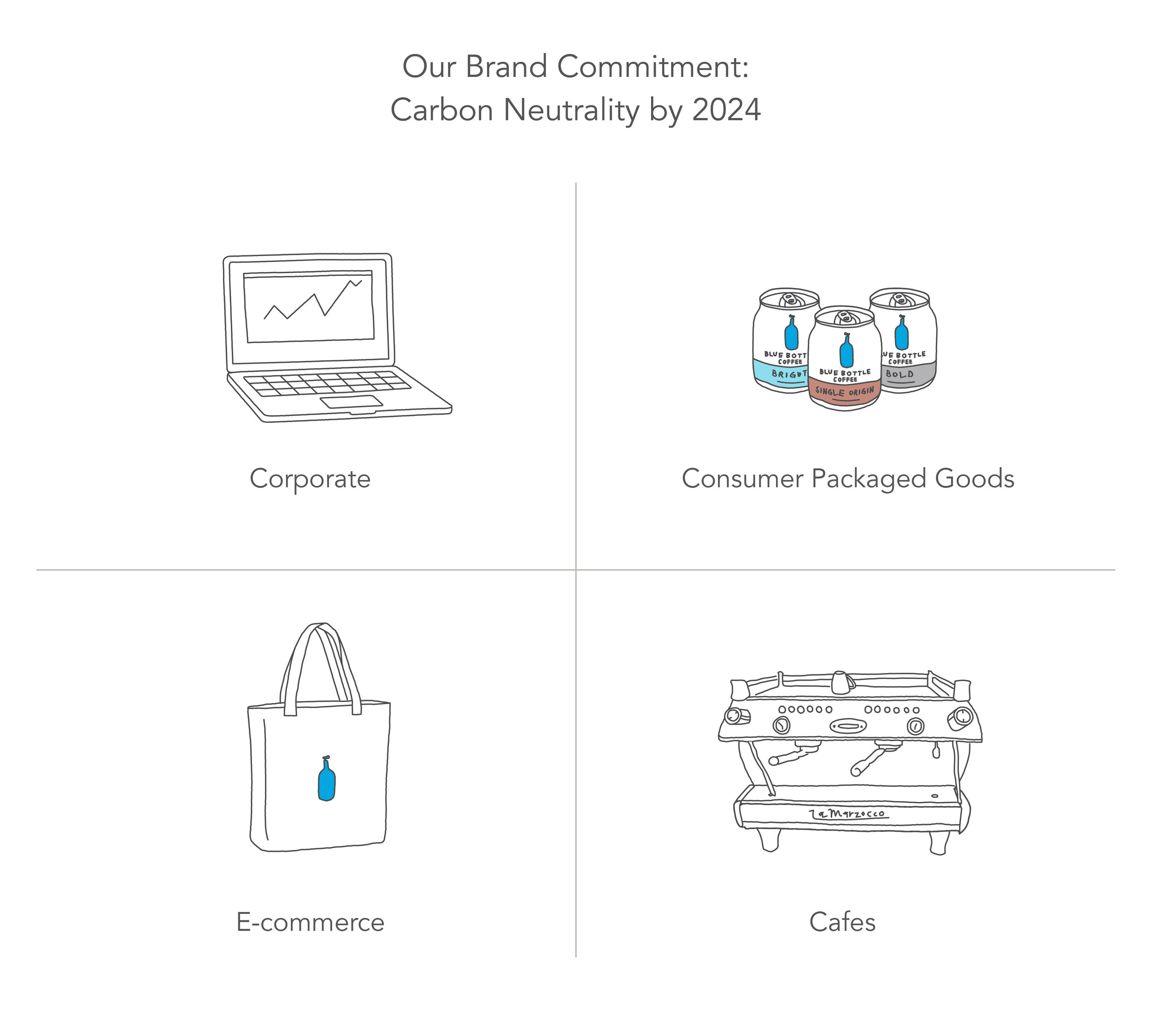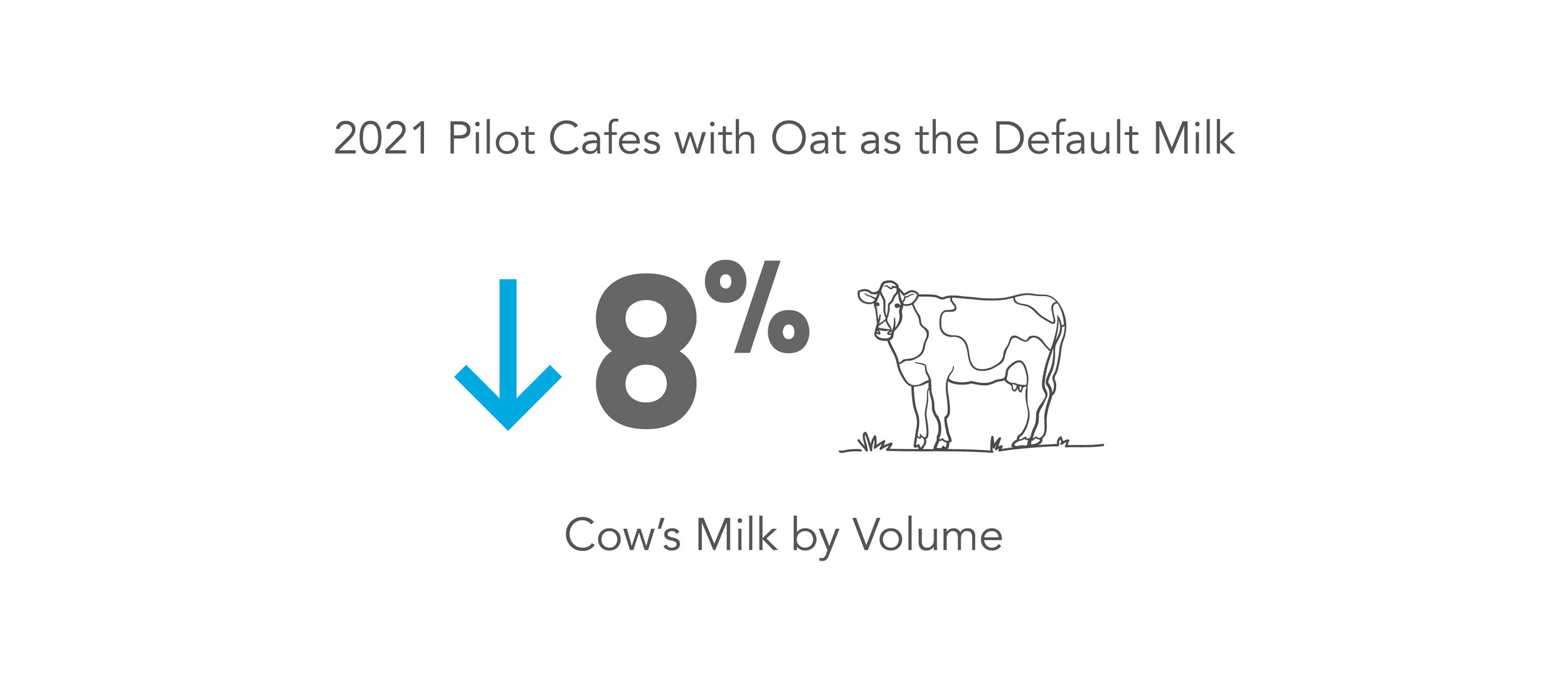Carbon Neutral by 2024
What we’ve built during the past year, and what’s next
Climate change is no longer an abstract concept or something that will happen far off in the future. It is here, and we see its effects regularly, from extreme weather that devastates communities to less predictable coffee yields.
At Blue Bottle, we ask ourselves daily: How can we deliver the Blue Bottle experience our guests expect and step up as leaders in the fight against climate change?
Already, Blue Bottle compensates for the greenhouse gas emissions associated with our e-commerce business on orders shipped throughout the United States—a commitment we made at the onset of the COVID-19 pandemic, when US cafes shuttered and reaching guests meant shifting online.
But humanity needs to do more if we intend to prevent irreversible damage to our planet and our communities. That is why Blue Bottle is going carbon neutral by 2024. This commitment extends across our entire brand, in the United States and Asia, and from coffee sourcing to end-of-life product and packaging emissions.
In order to reach our goal, accelerated reductions are a must. That is why we commissioned a high-level estimate of the greenhouse gas emissions associated with our cafes—Blue Bottle's largest business unit by revenue—and our coffee sourcing—the foundation of our Cafes, Consumer Packaged Goods, and E-commerce business units.
With this data in hand, in 2021 we prioritized reduction efforts across the following categories: electricity, coffee sourcing, dairy, and waste. In 2022 we will share a full roadmap to our 2024 carbon neutrality goal.
In this report, we focus on our greenhouse gas emissions reductions to date and provide an overview of where we are headed, including work with coffee producers and support to high-quality offsetting projects for unabated emissions once we reduce our own greenhouse gas emissions as much as possible.
REDUCTIONS
ELECTRICITY
In 2021, we focused heavily on reducing electricity emissions.
What we accomplished: Blue Bottle purchased renewable energy certificates in Japan and the United States to reduce emissions associated with a portion of our cafe and production sites.
In Asia, we were an early participant in Japan's new auction system. Five cafes and our first Asia roastery now receive renewable electricity tracked through government-issued non-fossil fuel energy certificates.
What's next: In addition to reducing electricity emissions through renewable energy procurement, we are examining how we can reduce demand at the operational level. We commissioned a cafe energy audit to recommend best practices for equipment maintenance and procurement. With refrigeration practices aligned to the guidance on installs and inspection, our next step is measuring energy utilization per equipment item. This will inform shutdown schedules, eco mode programming, and switching out parts for energy and cost efficiencies.
COFFEE SOURCING
Central to Blue Bottle's coffee-sourcing strategy is working with producers who prioritize the environmental health of their farms. Our suppliers have long practiced regenerative farming techniques aimed at improving soil health, enhancing quality of soil, increasing resilience to drought, pests, and disease, and boosting productivity. These methods also sequester carbon, helping coffee farming realize its potential to be a climate solution through greenhouse gas mitigation.
What we accomplished: In 2021, Blue Bottle commissioned a third-party assessment of greenhouse gas emissions reduction opportunities with coffee producers. We identified three focus areas for highest impact across our supply streams: organic certification, agroforestry and shade, and organic composting.
Blue Bottle also is receiving results from our first year of sustainability audits assessing, among other topics, environmental risks and best practices for 70 percent of our 2021 coffee purchasing.
What’s next: Blue Bottle will work with suppliers to sustain and expand regenerative agriculture in coffee production. With high-level reduction opportunities and farm-level audit data now in hand, Blue Bottle is bringing climate targets to the fore in conversations with producers for the first time, exploring ways to accelerate carbon sequestration for targeted climate impact.
DAIRY
Nearly 80 percent of the drinks ordered in our cafes come with milk, and the milk-heavy latte and cappuccino are two of our guests’ favorites. In order to reduce our dairy emissions and respond to the growing preference among guests for plant-based milk, we are experimenting with ways to encourage guests to order alternatives to cow’s milk.
What we accomplished: Coming into 2021, Blue Bottle already led the change in its Asia markets to introduce oat milk, after it became a popular option in our US cafes at no extra charge. By June 2021, three cafes in California—our Jackson Square, Brentwood, and Fairfax locations—made oat milk the default in our milk-based drinks, both for guests who order on the app and for those who order in the cafe. Many of our guests appreciated this change, and after two months, we now use 8 percent less cow’s milk in these cafes.
Because our guests at the pilot cafes already ordered more alternative milk than a typical US Blue Bottle cafe, if we expand the pilot, there’s a chance that a larger percentage of guests at other cafes might make the switch to oat milk with the potential to reduce our emissions even more.
In July 2021, our Williamsburg cafe launched a fresh alternative milk blend prepared onsite in reusable jars. We designed this milk to be delicious in coffee, texturally indulgent in espresso-based beverages, and a reduction in our dairy greenhouse gas emissions. Beyond the ingredient sourcing impacts of switching from dairy, preparing onsite allows us to forego the emissions of shipping heavy liquid.
What’s next: Come November, after evaluating both pilots, we will share what we learned and update how we plan to proceed.
WASTE
Blue Bottle cafes, production facilities, and the corporate office all collect waste bound for landfill, which we estimate drives most greenhouse gas emissions in this category unit-for-unit when compared to compost and recycling. Blue Bottle aims to divert more than 90 percent of its waste from landfill, incineration, or the environment across its US production sites beginning 2022, and to integrate best practices into cafe operations. Already US cafes and Blue Bottle’s cold brew production site compost coffee grounds.
What we accomplished: Our Jackson Square cafe opened this spring with zero waste operations and acts as a testing ground for sustainability initiatives. In its first month, the cafe achieved 98 percent diversion of its waste from landfill.
During the summer, two Blue Bottle cafes in each US market conducted zero waste audits to benchmark waste levels and disposal habits across the three cafe waste streams: compost, recycling, and landfill. After analyzing the data, teams generated cafe action plans to reduce waste from the source, reuse materials, and prevent contamination in recycling and compost.
Blue Bottle further has welcomed back personal cups for beverages ordered in the cafe, so together with guests we might change our throwaway culture.
What’s next: Teams will implement their zero waste audit cafe action plans, including finding ways to work with guests to ensure waste is sorted properly. For cafes that did not perform an audit, teams will receive monthly reports tracking their waste diverted from landfill based on order data calibrated to that market's audit results for actual disposal practices. Both quarterly zero waste audits and monthly diversion tracking will inform priorities and practices for individual cafe teams as they embark on their zero waste journeys. As we seek to annually increase our diversion rates, zero waste will require continuous improvement, innovation, and ingenuity.
In addition to shifting toward reuse, we need to maximize the environmental attributes of our single-use products. We will work to source more fiber-based takeaway ware, as this material breaks down most effectively in compost to serve as a soil amendment. From our cold case, we are re-evaluating our selections to determine if there are delicious, lighter-weight alternatives we can offer.
OTHER EMISSIONS SOURCES & REDUCTION TOOLS
The remaining emissions in our greenhouse gas inventory will fall into categories such as transportation, purchased goods and other ingredients, gas and refrigerants, and merchandise use. While these categories may represent smaller shares of our overall greenhouse gas emissions to be measured and verified in 2022, reducing emissions across the brand remains an imperative.
After aggressive steps to reduce as much of our greenhouse gas emissions inventory as possible, Blue Bottle will address unabated emissions by supporting high-quality offsetting projects like the first registry-certified agricultural carbon credits generated at scale. Blue Bottle has made a multiyear purchasing agreement for these credits, supporting US farmers transitioning from conventional to regenerative agricultural practices.
Regenerative agriculture has the power to remove carbon from the atmosphere, which the Intergovernmental Panel on Climate Change has reported necessary to hit the end-of-century climate target limiting warming to 1.5 degrees above pre-industrial levels and subsequently staving off the most damaging effects of climate change.
If we at Blue Bottle want to accelerate the transition to a net-zero global economy in 2050, per the 1.5-degree pathway, we must do our part after reducing emissions to prioritize mitigation activities removing carbon from the atmosphere.
NEXT STEPS
Our next steps are to perform and verify a life cycle assessment of the brand, then share the roadmap to 2024 carbon neutrality.
With 2021 underway, we have clear objectives for 2022:
Grow the portfolio of renewable energy
Measure and reduce energy from equipment usage in cafe operations
Elevate alternative milk at scale
Reduce waste to landfill beginning with education for teams and guests
And prioritize reductions in locations with higher emissions
Carbon neutrality by 2024 will require fundamental changes to our operations and partnerships with suppliers, new engagements with coffee producers incorporating climate targets, and guest participation in Blue Bottle's efforts to waste less and reuse more and to test lower-emissions product offerings.
We cannot do this alone, and invite guests to join us in forging change. Together we can take bold climate action, one cup of coffee at a time.




